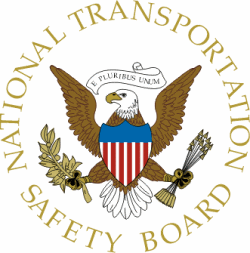Tue, Jan 12, 2010
Five Reportable Incidents Added To Notification
Requirements
 The NTSB is amending its regulations concerning notification
and reporting requirements regarding aircraft accidents or
incidents. In particular, the NTSB is adding regulations to require
operators to report certain incidents to the NTSB. The NTSB is also
amending existing regulations to provide clarity and ensure that
the appropriate means for notifying the NTSB of a reportable
incident is listed correctly in the regulation.
The NTSB is amending its regulations concerning notification
and reporting requirements regarding aircraft accidents or
incidents. In particular, the NTSB is adding regulations to require
operators to report certain incidents to the NTSB. The NTSB is also
amending existing regulations to provide clarity and ensure that
the appropriate means for notifying the NTSB of a reportable
incident is listed correctly in the regulation.
On October 7, 2008, the NTSB published an NPRM titled
"Notification and Reporting of Aircraft Accidents or Incidents and
Overdue Aircraft, and preservation of Aircraft Wreckage, Mail,
Cargo, and Records" in the Federal Register. This NPRM proposed,
and the final rule codifies the addition of five reportable
incidents, the reporting of which the NTSB believes will improve
aviation safety.
The operator of any civil aircraft, or any public aircraft not
operated by the Armed Forces or an intelligence agency of the
United States, or any foreign aircraft shall immediately, and by
the most expeditious means available, notify the nearest National
Transportation Safety Board (NTSB) office when an aircraft accident
or any of the following listed serious incidents occur:
-
 Failure of any internal turbine engine component that results
in the escape of debris other than out the exhaust path.
Failure of any internal turbine engine component that results
in the escape of debris other than out the exhaust path.
- In-flight fire.
- Aircraft collision in flight.
- Release of all or a portion of a propeller blade from an
aircraft, excluding release caused solely by ground contact.
- A complete loss of information, excluding flickering, from more
than 50 percent of an aircraft's cockpit displays known as
Electronic Flight Instrument System (EFIS) displays, Engine
Indication and Crew Alerting system (EICAS) displays, Electronic
Centralized Aircraft Monitor (ECAM) displays, or other displays of
this type, which generally include a primary flight display (PFD),
primary navigation display (PND), and other integrated
displays.
- Airborne Collision and Avoidance System (ACAS) resolution
advisories issued either when an aircraft is being operated on an
instrument flight rules flight plan and compliance with the
advisory is necessary to avert a substantial risk of collision
between two or more aircraft, or to an aircraft operating in class
A airspace.
- Damage to helicopter tail or main rotor blades, including
ground damage, that requires major repair or replacement of the
blade(s).
- Any event in which an aircraft operated by an air carrier lands
or departs on a taxiway, incorrect runway, or other area not
designed as a runway, or experiences a runway incursion that
requires the operator or the crew of another aircraft or vehicle to
take immediate corrective
- action to avoid a collision.
The final rule was published in the Federal Register January
7th, and the revisions and additions published in this final rule
become effective March 8, 2010.
More News
We're Everywhere... Thanks To You! Even with the vast resources and incredibly far-reaching scope of the Aero-News Network, every now and then a story that should be reported on sl>[...]
From 2015 (YouTube Version): Oshkosh Reveals Many Treasures... Including Old Warbirds Full Of History While at EAA AirVenture 2015, ANN News Editor, Tom Patton, ventured out to vis>[...]
"The aircraft achieved the maximum recorded airspeed of 180 Knots IAS at about 08:08:42 UTC and immediately thereafter, the Engine 1 and Engine 2 fuel cutoff switches transitioned >[...]
Temporary Flight Restriction (TFR) A TFR is a regulatory action issued by the FAA via the U.S. NOTAM System, under the authority of United States Code, Title 49. TFRs are issued wi>[...]
Aero Linx: Aviation Without Borders Aviation Without Borders, a leading humanitarian aviation charity, uses its aviation expertise, contacts and partnerships to enable support for >[...]
 ANN FAQ: How Do I Become A News Spy?
ANN FAQ: How Do I Become A News Spy? Classic Aero-TV: The PB4Y-2 Privateer - A Priceless Aero-Treasure
Classic Aero-TV: The PB4Y-2 Privateer - A Priceless Aero-Treasure Aero-News: Quote of the Day (07.14.25)
Aero-News: Quote of the Day (07.14.25) ANN's Daily Aero-Term (07.14.25): Temporary Flight Restriction (TFR)
ANN's Daily Aero-Term (07.14.25): Temporary Flight Restriction (TFR) ANN's Daily Aero-Linx (07.14.25)
ANN's Daily Aero-Linx (07.14.25)




